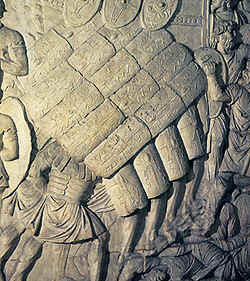The Roman Army was extremely important in explaining the success of the Romans and the expansion of the Roman Empire. The Roman Army, at the peak of its power, conquered what we now call England/Wales, Spain, France, most of Germany, the northern coast of Africa, the Middle East and Greece. The Ancient Roman equivalent would be:
| Britannia | England/Wales |
| Gallia or Gaul | France |
| Germania | Germany |
| Hispania | Spain |
| Aegyptus | Egypt |
| Achaea | Greece |
| Italia | Italy |
The Roman Army is recognised by historians as an extremely effective fighting machine. Ironically, its success also led to its downfall. The lowest level of soldier in the Roman Army was the legionnaire. Between 5000 and 6000 legionaries made up a legion that was commanded by a legatus. Legionnaires were trained to fight in a disciplined and co-ordinated manner. A whole legion could be punished for failing to fight well in battle – even if the Romans did win the battle itself! Training was brutal and tough but it paid huge dividends for the Romans.
A legionnaire went into battle equipped with three main weapons.
| The Pilum | This was similar to a javelin today. The legionaries would throw it at the enemy as they ran at them. It was not for hand-to-hand fighting. The main purpose of the pilum was to disrupt the defence of the enemy. They would be too concerned worrying about avoiding the incoming weapons to focus on what the legionnaires themselves were doing. By the time the enemy had re-organised itself, the Romans were upon them. If a pilum did hit you, it could do serious damage as the thinner top section would crumple into you on impact and removing it would be very painful. The wooden stock of the pilum was also re-useable as the Romans only had to add another spear head to it. |
| The Gladius | The gladius was the main weapon for the Roman soldier when he got into close quarter fighting. This was a sword which was kept razor sharp. Anyone on the receiving end of a blow from a gladius would suffer severe injuries. |
| The Pugio | The pugio was a small dagger used in combat if all else had been lost. |
Along with these weapons, the legionnaire carried a curved shield called a scutum. This gave the Roman soldier a great deal of protection as it curved around his body. It was also used by the Romans when they used what was known as a tortoise formation to move forward to a target that was well defended. A ‘tortoise’ was when the soldiers lifted the scutums flat above their heads so that they effectively interlocked and protected them from any missiles thrown at them from on high.
|
The ‘tortoise’ in action |
![]()
